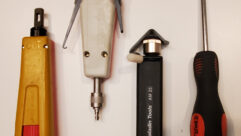Redesigning the 19th Hole
Sep 1, 2002 12:00 PM,
By Joel Bump
Long a jewel in the golf world, the Doral Golf Resort features five professional-level courses, including the Greg Norman — designed Great White, Raymond Floyd’s Gold Course, and the famed Blue Monster. The Miami resort, which features a PGA event every year, offers guests spa and dining services, as well as use of the facility’s grand ballroom and conference center.
The resort — which is in the middle of a $75 million, comprehensive renovation — underwent an upgrade to its ballroom and conference center. The project included new wall finishes and fresh carpeting to preserve the comfort and elegance of the seven meeting rooms. A stately hall opens left into the oval grand ballroom, which is equipped with two moveable walls that allow it to be divided into three smaller rooms. Directly across the hall are entrances to the pavilions, which can be partitioned into four rooms.
In early 2002, Mike Melcher of Revelation Sound proposed a new sound system to Carmine Rondinelli, the director of catering, who agreed that the facility’s electronics needed to be upgraded. The technology upgrade of the ballroom and conference center proved to be simple, quick, and easy, Melcher says.
STARTING TIME
The goal was to retrofit each zone with a new wall control interfacing with new system controllers in the equipment room. Three considerations were paramount in the choice of a new system, says Melcher. First, the retrofit installation’s tight schedule meant the new system needed to make use of existing wiring. Second, system operation needed to be simple enough that any catering or maintenance staff member could easily operate it. Finally, the cosmetic design of the user controls had to blend with the elegant decor of the facilities. Acutely aware of the need for reliability and support, Melcher says he limited consideration to solid companies with an established record of high-quality manufacturing. Features such as stored preset levels and VCA level control also played an important role in the system selection.
Revelation Sound had previously updated the input side of the facility. The company had installed three mic jacks in each room, which feed Shure automatic mic mixers and feedback controllers. TOA power amplifiers provide 70V to custom speaker switching panels feeding overhead speakers in each zone. These custom panels let an individual speaker be selectively turned off if microphones are set up directly under it. Melcher also opted to keep two existing Crown amplifiers and an Atlas/Soundolier SACR-191 power sequence switcher as part of the new system. The new room-combining system would be added to this equipment, which is based in a small rack room adjacent to the meeting rooms.
The equipment racks were connected to double electrical boxes in each zone by standard electrical conduit. Although new wire could be pulled in, a 4-conductor cable was already in place in the conduits. Prior to installation, Melcher and one of his crews followed the conduit paths through the building. Routing was through plenum areas, where they were secured to several strut channels with electrical and lighting conduits. That created multiple ground returns for the conduits, leading Melcher to conclude that the conduits would serve as a reliable ground for wall controls, provided the controls operated exclusively with DC voltages. However, Melcher expressed concern that controllers using serial communications might be disrupted by signal impulses or AC voltages that could accumulate between electrical conduits.
Melcher decided to choose RDL‘s RCX room-combining system. The RCX-5C controllers met all system requirements, and the RCX-1 room controls come with RDL’s Ultrastyle design, which complements the hotel’s decor. Other deciding factors included the RCX-5C provision, which allows the two room groups to be linked together when all seven zones are used for large events. The RCX-1 wall controls are DC based, using 10V control pulses that provide immunity from the effects of potential ground variations. RCX-CD1 custom control panels were to be mounted in the equipment racks to permit quick visual status and simple single-button control of adjacent room combinations.
The RCX system also lets the installer store separate preset levels for the microphone and background music sources in each room, with an LED display of the operating level. “Those were all important factors,” Melcher says.
TEEING OFF
The resort blocked off two days for installation of the new equipment. As part of the facility renovation, the carpet was replaced at the same time. The equipment arrived on a Wednesday morning and was unboxed for installation. Melcher supervised the installation with two techs, Manny Lima and Carlos Chavez, assisting. After removal of the old equipment, installation of the RDL RCX system began in the afternoon.
Before the two RCX-5C controllers were racked, each was powered up in the Setup mode, and the appropriate room layout was selected and stored using the front-panel buttons. The configuration was taken directly from the installation instruction diagrams and required less than one minute to program. Each RCX-5C controller is powered by an RDL PS-24U2 24 VDC 2A power supply. The two power supplies were first rackmounted using RDL PSB-1 power supply brackets fixed in an RDL RU-RA3 rack adapter. Each RCX-5C controller was rackmounted under its associated RCX-CD1 custom control panel.
While Melcher mounted the equipment and wired the audio, Lima and Chavez removed the old wall controls. The original construction used mud rings affixed to dual gang electrical boxes. The front opening in the rings was smaller than the clearance required for the RCX-1 wall controls. However, the RCX-1’s shallow profile allowed the mud rings to be turned around. With the rings facing into the box, the RCX-1 controls easily mounted flush to the wall. Revelation Sound did not need to install the RDL RCX-compatible mud rings, though they are available for retrofit installations.
Line-level audio from each mixer was connected to the controller, and its audio output for each zone was wired to the power amplifiers. The house background music was wired into each RCX-5C controller. Melcher wired the remote wall control conductors to the rackmounted controllers while Lima and Chavez wired and mounted the RCX-1s in the seven rooms. A simple stereo patch cord was installed between the Link In and Link Out jacks of each RCX-5C. The Link option allows complete audio cross-coupling between the controllers when both controllers are set to the All Combine mode. That feature is occasionally used when all doors are opened up to the pavilions and ballroom for a large event.
Before wrapping up for the day, Melcher applied power to the RCX-5C controllers so the input levels could be set. Each of the five possible room inputs has a front-panel volume adjustment. Above each knob is a standard RDL dual-LED meter. The green LED on the left varies in intensity in proportion to the audio level. The right red LED pulses when the audio level exceeds the proper operating level. Adjusting the input levels is similar to adjusting levels on a standard VU meter. It took a few minutes using a microphone in each room to adjust the input levels. The rear panel Music trimmer was also adjusted using the Music front-panel dual-LED meter.
A SECOND ROUND
The next morning was reserved for setting the stored system levels. In the RCX system, a preset level is stored for the local (microphone) source in each room. A different preset level may be stored for the music source in each room. Each time a source is selected in a room, the controller sets the level to the associated preset value. The first step in establishing the desired levels was for the installers to decide how much gain range users would be allowed. The local level on the RCX-1 was set to maximum, and the associated power amplifier was adjusted for the highest allowable level.
Melcher did several mic checks while ramping the level up and down on an RCX-1. He determined that users would have optimum gain trim adjustment in each room with a preset level corresponding to an indication of 50 percent (five of ten LEDs) on the RCX-1 level indication string. The Preset store button on the back of the RCX-5C was pushed, and that level was stored, as verified by the adjacent LED button. The level was ramped off, and the procedure was repeated for the other six rooms. Similarly, the desired music level was set for each zone.
The level chosen by Melcher provided about ±18 dB of gain range at the room control. Although all the levels were checked and stored during this installation, the RCX-5C factory default setting is ±18 dB. “In most cases, the controller could come right out of the box and be used without doing any level storage,” Melcher says.
Level storage on the RCX-5C was straightforward. The unit will store a room level only when levels are turned fully off in all other rooms. That precludes the possibility of inadvertently storing an incorrect value. Setting and storing both the local and music levels in each of the seven zones required less than one hour. The final check of the installation involved verifying correct wiring by setting each possible combination of rooms on the RCX-CD1 custom control panels in the equipment rack. Mics were plugged in, and the speakers were checked for proper zone operation and levels.
TRAINING DAY
System operators and supervisors gathered midday for system orientation and training. Melcher demonstrated the operation of the RCX-CD1 control panels in the rack room and then proceeded to the ballroom to explain the operation of the RCX-1 room control. Hotel staff found the system straightforward and easy to understand. The resort A/V director, Larry Friedman of Presentation Services, was particularly pleased to learn that the room source is locked in the local position when a room is combined. He cited repeated instances in the past when a customer would inadvertently shut off the mics after the resort staff had set up the room. “It was always happening,” Friedman says. “As soon as we would get called, we knew what it was.” The RDL system automatically disables in-room source selection when rooms are combined.
In an independent (not combined) room, the RCX-1 momentary keyboard-style push buttons allow a user to select the music or the local (microphone) source. When the Music button is pushed, house background music is switched on at the music preset level stored during system setup. Pushing the Local button selects the room source(s) and sets the level to the local preset level established during setup. When a room combination button is pushed at the controller rack, the source in each associated room automatically switches to the local source at that room’s local preset level. The music source remains unavailable until the room is uncombined.
SCORECARD
Several RCX system features were not required in the Doral installation. The RCX controller provides for emergency paging, which can supercede the audio in all rooms. In facilities that use switches to detect partition position, the RCX-5C can be controlled automatically. It also has a provision to activate automatic partitions. Because the Doral Golf Resort already had input jacks and mixers in place, the mic inputs on the RDL controller were not used. For installations requiring a single mic jack or a mic jack that includes unbalanced line-level inputs, the RCX system offers wall plate assemblies that match the room controls. The RCX controller includes an integral studio-quality microphone preamplifier input as well as the line input for each room. A variety of room controls are also available, including optical rotary encoder level control or key switch operation.
The dominant features of the Doral installation were the programming simplicity and ease of installation. At the conclusion of the installation, Melcher said the whole job took only a day, and the staff training required only 15 minutes. “This is the easiest installation I’ve ever been involved with,” Melcher says.
Joel Bump is a former news reporter and is director of engineering for RDL.
For More Information
Atlas Sound
WWW.ATLAS-SOUNDOLIER.COM
Ž 213
Crown
WWW.CROWNAUDIO.COM
Ž 214
RDL
WWW.RDLNET.COM
Ž 215
Shure
WWW.SHURE.COM
Ž 216
TOA Electronics
WWW.TOAELECTRONICS.COM
Ž 217
Ž Circle this number on Reader Service Card for more information.










